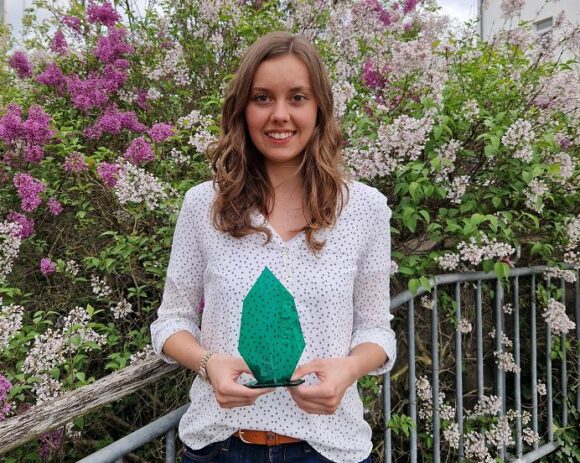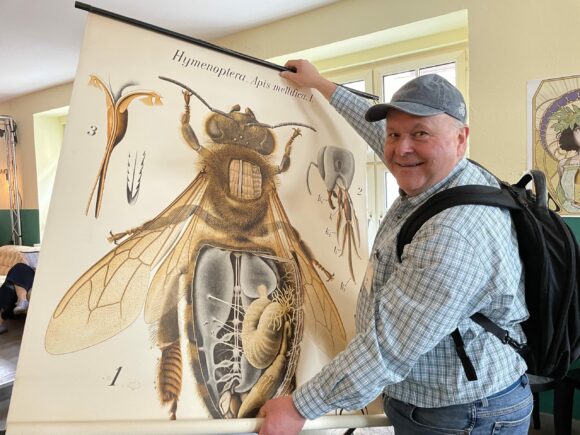In our time, the topics of sustainability and lightweight construction are becoming increasingly important. These are indispensable in order to be able to achieve the climate and environmental goals that have been set. The aspect of lightweight construction technologies is to save weight, material and thus energy while maintaining at least the same functional properties.

In order to establish lightweight construction sustainably in our society, material combinations must be thought of in a new, but also economical way: Innovative processes and materials should pave the way for the products of our future. This is precisely where the project “GePaV – Development of an automated process integrated into the weaving process for the production of fabric-particle foam composites”, launched in October 2022, comes in. Together with the companies Indorama Ventures Mobility Krumbach GmbH & Co. KG, SCHRAML Metallverarbeitung GmbH & Co. KG, Collischan GmbH & Co. KG (subcontractor) and Neue Materialien Bayreuth GmbH (NMB), the Institute of Materials Science (ifm) at Hof University of Applied Sciences is researching novel materials in the combination of textile fabrics and particle foams as well as the process technology for economical production.
Advantages of the materials combined in a new way
Fabrics are found in our everyday use primarily in clothing, decorative textiles, but also in technical applications such as airbags in automobiles. Particle foams, on the other hand, are known, for example, as soles in running shoes, for insulating materials, in numerous automotive applications – e.g. in bumpers, but also in helmets for shock absorption. Due to their extremely low density, these offer optimum conditions for being used in lightweight construction applications. Due to their excellent formability, they can easily be manufactured into components with complex geometries. In comparison, the textile material is characterized by its flexibility, customizability, the combination of design and function, and the possibility of reinforcing the components.
So why not combine the advantages of both materials to create a novel material for lightweight construction? That’s what the researchers thought when the project idea was born. “First, of course, we had to test whether the idea had potential and could be implemented” recalls Alexandra Luft, research group leader at ifm. “To do this, we produced lab-scale samples together with NMB, which we presented to potential partners.” And further:
“The response and interest were so great that a consortium was formed in a very short time and a corresponding application was submitted to the ‘Bavarian Joint Research Program – Materials and Materials’, which has now been successfully approved.”
Alexandra Luft, research group leader

Processes linked in a new way
In the project, Indorama Ventures Mobility Krumbach GmbH & Co KG, Collischan GmbH & Co KG and ifm are responsible for the development of weaving and integrated filling process as well as corresponding multilayer fabrics with and without spacer threads, Neue Materialien Bayreuth is responsible for the preparation of particle foams and the development of the suitable foaming process, while SCHRAML Metallverarbeitung GmbH & Co KG designs tools for the production of 3D composites. At the end of the 30-month project, there should be an innovative in-situ manufacturing process for fabric-particle foam composites in an economical process chain. The newly manufactured materials are to be used in automobiles, in sports and in occupational safety and health, where they will not only reduce weight and energy consumption, but also provide greater comfort and safety.

from left to right: Dr. Recep Kocaman (ifm), Philipp Heinz (Collischan GmbH & Co. KG), Corinna Anzer (ifm), Markus Bernhardt (Indorama Ventures Mobility Krumbach GmbH & Co. KG), Alexandra Luft (ifm), Kristina Schüllner (Neue Materialien Bayreuth GmbH), Norbert Huber (Indorama Ventures Mobility Krumbach GmbH & Co. KG), Dr. Enrico Putzke (ifm), Peter Schreier (Neue Materialien Bayreuth GmbH); Image: Hof University of Applied Sciences;
Acknowledgements
The consortium would like to thank the Bavarian Ministry of Economic Affairs, Regional Development and Energy for funding the research project: “GePaV – Development of an automated weaving process integrated into the weaving process for the production of fabric-particle foam composites” under the funding code MW-2112-0020.









